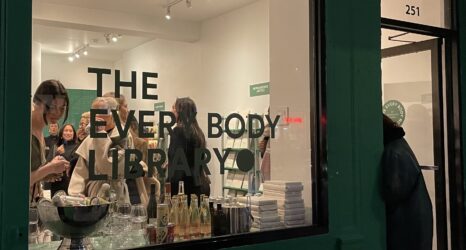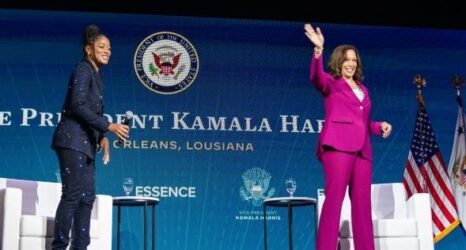Since the show first aired on Hulu in the spring of 2017, The Handmaid’s Tale, an adaptation of the famous dystopian novel by Margaret Atwood (1985), has served as a prescient, if fictional, cautionary tale about the horrors of a society in which women’s reproductive, social and political rights are determined and restricted by the State.
In the last two years, the red dress and winged bonnet assigned to the class of fertile women known as handmaids in the fictional Republic of Gilead has become one of the most iconic costumes of our era. We have designer Ane Crabtree, who worked on the first two seasons of the show, to thank for this instantly recognizable symbol of resistance.
A costume designer for 30 years—with an impressive resume that includes Westworld, Masters of Sex and The Sopranos—Crabtree received a 2018 Costume Designer’s Guild award and was nominated in 2019 for an Emmy award. She caught up with Ms. while she was driving home to New York City from Kentucky, where she grew up as the daughter of a white father and a mother of Okinawan descent.
You know what I was trying to do? I got gas, and I was trying to find a Handmaid’s Tale quote, because I can never remember the full quote, but I love it all, so we’ll just do what we can.
I wouldn’t expect you to remember anything verbatim!
No, but I’m a huge fan. I read the book so long, 30 years, ago—and, of course, read it for the show—but then stopped early on because it’s dangerous to read a novel while you’re reading a script. Very late Season 2, I went away into the woods and just began reading and fell in love all over again. I was getting ready for an exhibition in Georgia of show costumes, and was asked for my favorite quote, singular. I think I gave them 50, which can explain my love affair with the book.
Reading anything inspirational has more impact today. Just before I got gas in Ohio where, in early July, they blocked the abortion ban for a bit, I happened to look up before I got out of the car and I saw this really beat up old truck that had the sticker “Resist.” I thought, man, this is such perfect timing.
Absolutely. Do you have any memory of your first experience reading the book? You said you read it 30 years ago; what was that like?
I’m 55. I was a young girl. I moved to New York when I was 21 in 1985. I get a bit confused between the book, which came out in ‘85, and the film, which came out in ‘90. Both were highly impactful and in different ways.
The biggest takeaway for me was that I couldn’t move after reading it, during reading it; I couldn’t move watching the film, I couldn’t leave the theater. It just took the air out of me. It was one of those moments when you’re becoming who you are as an adult and as a woman and you haven’t quite formed your take on things. I was coming from a quite conservative, tiny farm town to this open world of thoughts and ideas and feminism.
I think what [The Handmaid’s Tale] did is it said: “Stop. Take a look around. Maybe your reality isn’t your reality.”
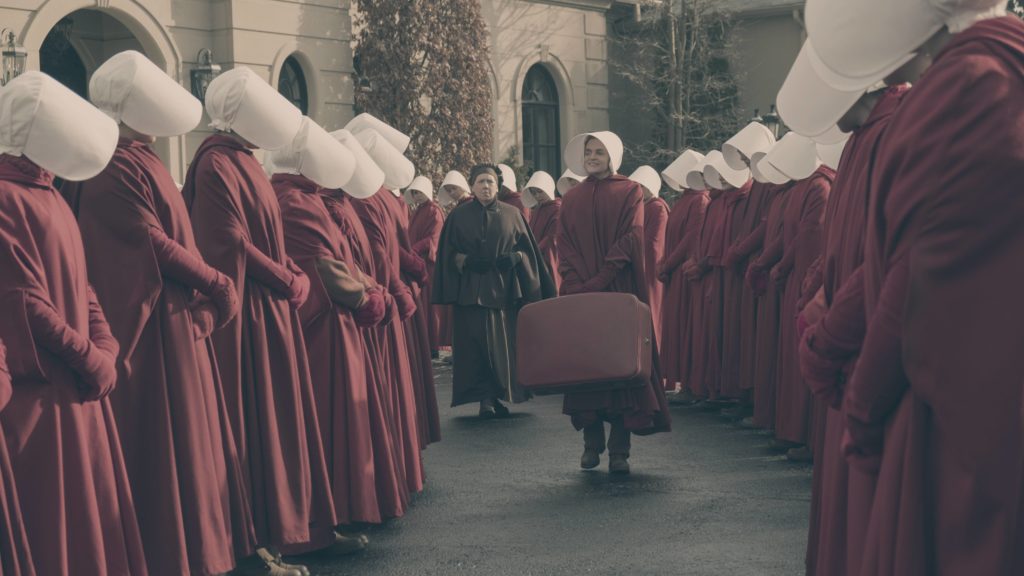
One way to think through that is to ask how you then funneled that feeling into your design.
And therein lies my frustration with not being able to find the full quote! [Author’s Note: Scroll down.]
I surround myself with images that nearly have nothing to do with the costumes, more to do with emotion or things that are synonymous with words. There’s no space on the wall, and there’s so many images, and it’s kind of a visual bombardment of inspiration that crowds my brain, and then, within that are quotes.
I had this one quote from Margaret Atwood’s novel over my desk. I had it over my desk because it was speaking of the moon and how June, or Offred, was looking out because you could only see a sliver out the window and she saw the moon—and that’s freedom, right? No one can harness your imagination. It was about dealing with and looking at the ugly, as we all do during war, or during times of revolution or during times exactly like today, with women’s rights and immigrants’ rights and everything that’s just taken away.
I’m a child of an immigrant and a child from poverty. I’m a woman who’s been through various forms of abuse. I know that those mind games of making something beautiful out of ugly is what I do for a living. I want the world to feel that. So, if you can inject a little ugly pretty, that’s the reality. That’s what makes something poignant and touchable.
That’s what that quote means to me: how to train your mind and be more expansive than the mental shackles that are put upon it by society’s rules.
I know it was a while ago now that you made the initial designs, but could you talk about how some of those things—layers of oppression and manipulation—are coming across in the women’s costumes on the show?
I’ll never forget the very beginnings of that show, because that’s the moment of creation, and no artist forgets that. I wanted it to be universal. I wanted it to be timely and I wanted it to be shocking, but real.
It’s very difficult. It’s one of the hardest things, because you want to look at something visually, like a Handmaid’s dress, and say—oh dear God, I knew that woman in the car crash on the news. It wasn’t that you were looking at the dress. It was like, I recognize her, and her has many names.
I wanted something universal that did not speak to one religion. I was raised Buddhist and Christian. I didn’t want to call out anything in particular. I wanted all those uniforms that make up that society to speak to everybody, to fill them with fear, but to be not so abstract that it was somebody else’s life. Our life. It’s our life.
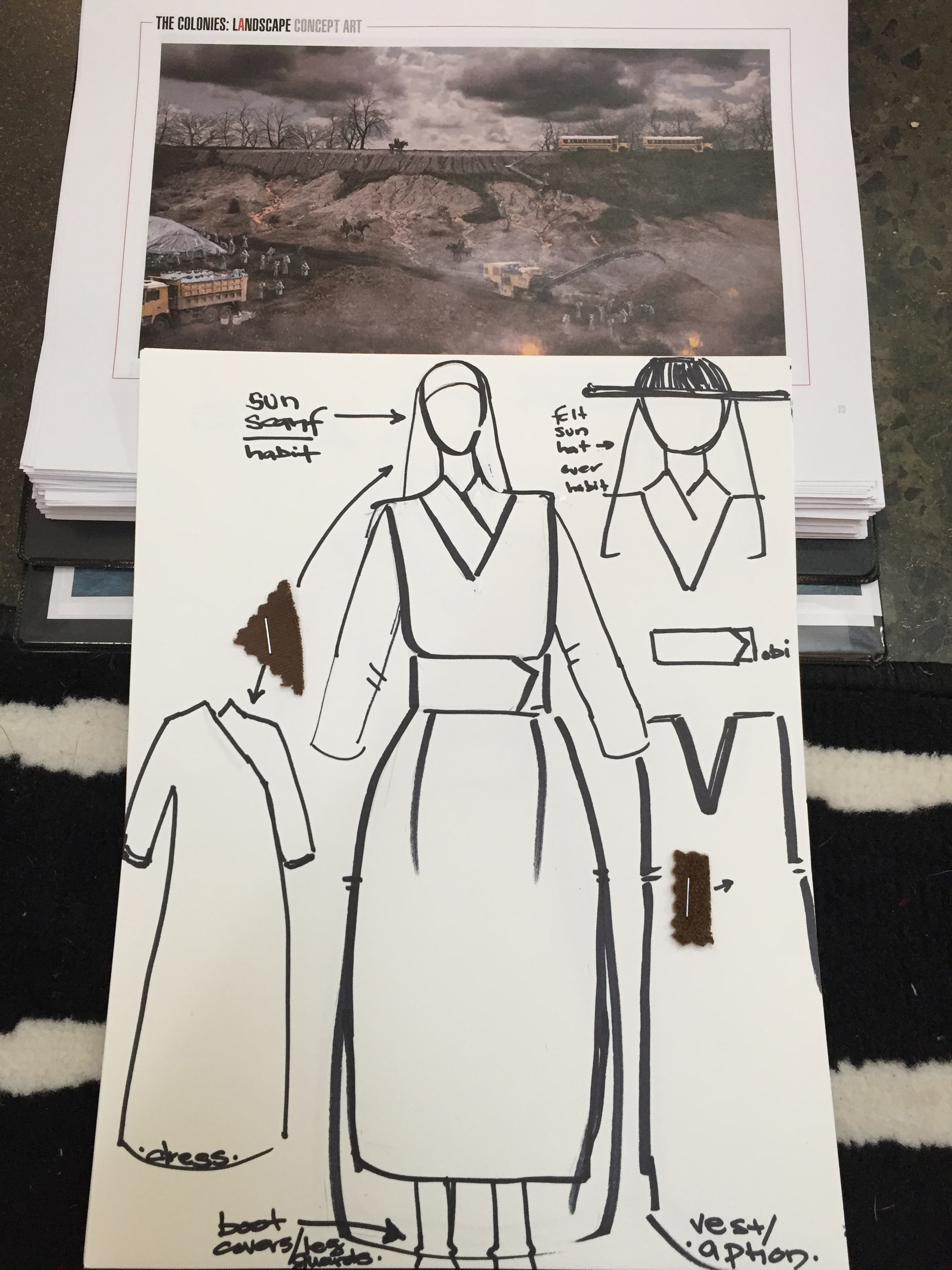
You can see that with the way people have been using the costumes for protests, something I know you’ve talked about elsewhere.
It’s very abstract. I finished the first season a week after NARAL used [Handmaid costumes] at the Senate in Texas. That was very emotional. It was sort of out-of-body emotional. The kind of weeping one does when you lose someone, you know?
I think I didn’t feel worthy, to be honest with you. I didn’t understand my place in it. The costume went to the Smithsonian in the fall and all these great things have happened. It’s almost a thing that’s a few steps ahead of me that I kind of keep it ahead of me a little bit out of self-preservation.
I don’t want to sully it in any way by making anything trite. I’m very proud. I guess I’m most proud that it has a voice for women in a really true way.
For me, one of the things that’s complicated and fascinating about the way the costume functions on the show and in the way people have been using it at protests is that the dress is doing at least two things all the time. In Gilead, for the women who wear them, they symbolize sexual servitude; for the ruling classes, they symbolize fertility and even hope. In the protests, people are using them as a sign of unity and strength between women, but also as a symbol of oppression.
I think the notion of what is happening in fiction in the imaginative world of Gilead to women, it’s so outrageous and so archaic. Nothing has changed in hundreds of years. Design something that speaks to that. Here we are in modern times, everyone’s dressed in tight Kardashian clothes. I wanted the opposite of that. I wanted something that was shrouded because that’s the way you control people.
I was sexually abused. I’m very open about that. Because of that history, I’m a tomboy. It happened very early on as a child. I started wearing my brother’s clothes out of financial necessity, but it also helped me to hide. I still do to this day. I’m uber-feminine, but shaved my hair, because that works for me, it helps me balance everything visually.
What I did was do the same thing in the costumes. Commander Waterford and Commander Lawrence, who was introduced at the end of Season 2, they’re saying: This is how it’s going to look. As the architects of Gilead, this is how we will control the masses in our new world. We will shroud the women. We’ll make them red so that you can see them. And we’ll make them chaste.
I put a little piece of fabric in front of the dress that’s long. It’s also great on camera because you can show the Ceremony. [The men of Gilead] want a woman’s sex because it’s the way to have progeny—and yet, they don’t really want to see it, because that’s too powerful. Right? So, you put a piece of fabric over it, a veil.

Obviously, all this attention to detail has paid off. You’ve been nominated for two Emmys now. One this year and one last year?
I just got nominated again right before I left for Kentucky. This is my third one and I’ve never won. We laugh and say, well, I’m in the Smithsonian, but I got no Emmys. It’s a difficult thing. I won a Costume Design Guild Award in 2018 for a contemporary show, [for] Handmaid’s Tale. But I was told [for the Emmys] that they were going to push it into the sci-fi show [category]. Margaret Atwood has said continuously, when she wrote the book up until now, this is not sci-fi. Nobody can categorize this show visually. It’s a present-day show. You and I both know what’s happening in the world. It couldn’t be more present day.
What you were saying earlier really struck me—when you were talking about how it should be familiar and universal but not abstract. It’s uncanny because it’s not right. There’s something about everything that’s going on that is not the way it should be. And yet, at the same time, it’s very recognizable. And I think that’s one of the brilliant things about your design.
I grew up really quiet. I grew up multi-racial in a town that was bizarre, in a time, the 60s and 70s, when other races just didn’t know what to do with me and my mom and brother. So, I have found ways to scream via my work, creatively, in my art, before I was ever a costume designer. It’s an amazing medium because nobody can point out anything that you’re really doing. They just think, it’s costumes. But what I love is that I’ve been able to shout in a way that helps me in my work, and certainly in The Handmaid’s Tale.
I think other women have felt that—that’s what they’ve told me—that’s why they don the costume, because you don’t have to say a damn word. You’re really making men angry. As you can see, all over the world, women are protesting. [People] are so petrified of the silence, and the powerful shouting silence, this costume brings, that they were forced to remove their wings in the Senate, but the men could still wear hats if they had them on their heads. Right. That’s powerful.
We all have to pay attention as women, and as people who are expressing themselves, whether it’s creatively or otherwise. There’s no accidents… I have a very romantic view of Kentucky from childhood, but it’s heavily laced with lots of violence and craziness. And as soon as I hit Kentucky, looking at these beautiful pastoral fields, farmland, there were all these little tiny white crosses punched into the Earth, lined up, millions and millions and millions. And there was a very large billboard on the ground of a baby’s face.
It was the patriarchy’s stance on abortion that every young woman has to pass going and coming from that spot on the highway—and it’s next to the highway, not even far away; it’s so blatant. I just thought, dear God, you can create fictions every day, all day. You can delve from reality every day, all day in your work. But there’s nothing like a power sucker punch like that.
You know, what’s amazing is that was going, on the journey, and then coming [back] was the “Resist” sticker in Ohio.
So, I feel like, maybe, we’re ending on a really beautiful note.
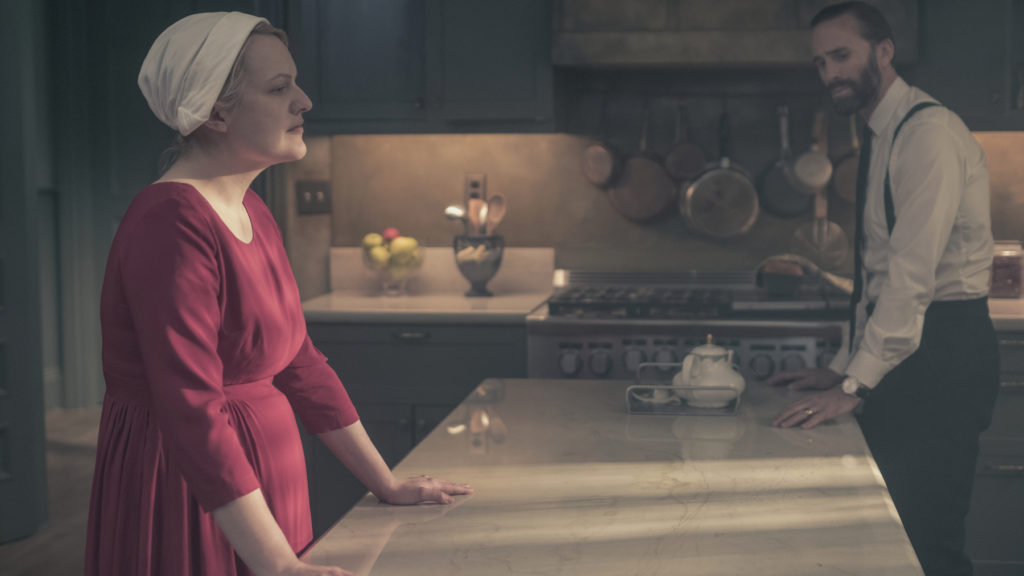
A few hours after we’d spoken, Crabtree emailed me the full quote from Atwood’s novel that she’d wanted to share:
The moon on the breast of the new-fallen snow. The sky is clear but hard to make out, because of the searchlight; but yes, in the obscured sky a moon does float, newly, a wishing moon, a sliver of ancient rock, a goddess, a wink. The moon is a stone and the sky is full of deadly hardware, but, oh God, how beautiful anyway.




